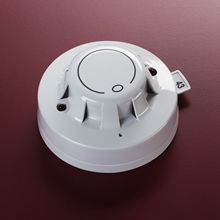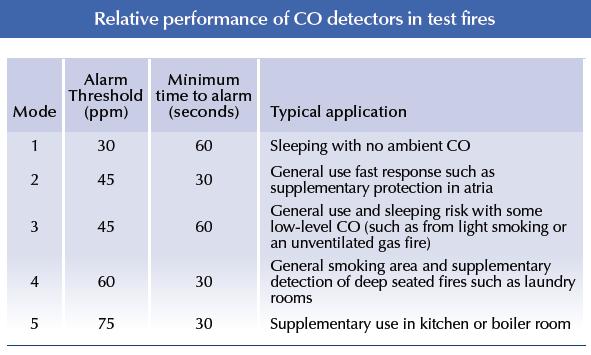DISCOVERY, CARBON MONOXIDE DETECTOR 58000-300
 | DISCOVERY CARBON MONOXIDE DETECTOR |
Operating Principles
Discovery CO fire detectors contain a long-life electro-chemical carbon monoxide sensor which is tolerant of low levels of common vapours and household products. The sensing technology is fast, accurate and needs only very low power. The detection capabilities are enhanced by a ratesensitive response. Fast rises in the carbon monoxide level are often associated with hot fires and the detector will respond earlier under these conditions. The analogue reply from the detector is rate limited to remove nuisance alarms resulting from short-term high levels caused by sources such as pipe smokers or gas flame ignition.
Application
CO detectors do not detect smoke particles or heat and are not universal replacements for smoke detectors.
Apollo does not endorse the use of CO detectors as the main method of fire detection if:
• the protected area is an escape route
• there is a requirement to detect
overheating of electrical equipment or cables
• the protected area is exposed to sources of CO such as vehicle exhausts, or to hydrogen or to high levels of alcohol vapour as emitted by some cleaning agents there is a requirement to detect fires involving flammable liquids
CO fire detectors are particularly suitable for supplementing smoke detection when there is:
• a deep seated smouldering fire risk
• a risk of fire starting in an enclosed space
• a likelihood of stratification taking place
Carbon monoxide detectors may be used as the primary fire detector in areas where the following conditions exist:
• the main risk is smouldering fires
• optical smoke detectors are deemed unsuitable (see ‘False Alarms’ below)
• the fire compartment is not greater than 50m2
Typical applications include hotel bedrooms, halls of residence, sheltered accommodation and hospital wards.
Detector Siting
CO fire detectors should be sited using the recommendations from BS5839: Part 1 (or other applicable code).
In the development of a fire, smoke and CO in the smoke plume is spread by convection to a fire detector. As CO is a gas, it further spreads—likesmells—by diffusion. For this reason CO may reach a detector faster than smoke would. This potential advantage can be exploited when designing a fire protection system and CO detectors may be used for supplementary detection. Equally, the opposite effect might occur, with CO moving away from a detector.
The behaviour of CO is therefore unpredictable and diffusion should not be relied on when designing a fire protection system.
False Alarms
Carbon monoxide detectors are less susceptible than smoke detectors to false alarms from sources such as toast, steam, cooking, plumbing work and hair spray. They may therefore be used in some applications in which smoke detectors would be susceptible to unwanted alarms.
Conversely, they may be more susceptible than smoke detectors to false alarms from fumes containing CO, such as vehicle exhausts, open fires and gas appliances.
- Discovery CO detectors should not be used with isolating base 45681- 321. Use 45681-284.
- 2. It is necessary to wait 30s after power-up to receive valid data from the CO detector.
Limitations
Carbon monoxide detectors also have important limitations. They are set to a higher sensitivity than the maximum allowed by the domestic CO alarm standard and will respond to CO from faulty gas appliances or vehicle exhausts. These detectors should not be used in place of carbon monoxide alarms complying with BS7860 or UL2034.
Operating modes
The Discovery CO detector has five operating modes, each having a set combination of sensitivity and response delay, which the user can select for any given application. See table below.
Drift Compensation
In view of the inherent stability of CO cells, there is no need for Discovery CO detectors to compensate for drift. Discovery CO detectors are set to report a drift value of 16.
Cell Test
The Discovery carbon monoxide fire detector has a remote test feature, which is used to verify that the electrochemical cell is fitted and that it is active. A test must be carried out at least once a year but preferably more frequently to ensure that the cell has not dried out. (Note that the cell will not be affected by the test, even if the remote test is carried out once a day.)
If the test indicates a sensor failure, i.e.the detector returns a pre-set analogue value of 25, the detector should be sent to Apollo’s Service Department for cell replacement and detector recalibration. When carrying out the cell test observe the 30s delay referred to above.
Precautions when investigating alarms
It is important to remember that CO is a colourless, odourless gas, which is not directly detectable by human senses. If a CO fire detector is in an alarm condition, it is possible that a dangerous level of CO exists around the detector. Extreme care must be taken when investigating alarms from CO fire detectors even if no combustion products can be seen or smelled.
Because of this danger, it is imperative that CO fire detectors are correctly identified at the control panel so that personnel investigating alarms may take the relevant precautions.
Maintenance and Service
The electrochemical cell used in the Discovery CO fire detector has a more limited life than would normally be expected from a smoke detector. In a typical environment, the life of the cell is seven years.
High temperature or low relative humidity can, however, reduce the life significantly. The limits given in the section ‘TECHNICAL DATA’ overleaf should be carefully observed.
It is essential that systems using CO fire detectors be correctly maintained and that the maintenance schedule include functional testing of the CO fire detectors.
CO fire detectors will not respond to the aerosol testers commonly used for the in-situ testing of smoke detectors. The Apollo (No Climb) detector tester with a CO test gas canister can be used to test CO detectors.
If there is any doubt over the sensitivity of a Discovery CO fire detector it should be returned to Apollo for servicing and calibration.
Note:
The CO detector can not be tested with the Discovery Test Set
Health and safety guide lines
This product contains a sealed electrochemical cell and in normal usage represents no chemical hazard in the sense of COSHH and the Health and Safety at Work Act 1974. Chemical hazard can, however, arise if the following notes on storage, handling and disposal are not observed.
For maximum life, the product should be stored before installation in clean dry conditions between 0°C and 20°C. It should not be exposed to temperatures outside the range –40°C to +55°C or to organic vapours.
The electrochemical cell contained in this product is fitted into sockets on the printed circuit board; to avoid damage to the cell do not remove it.
The electrochemical cell contains sulphuric acid in a relatively concentrated state. In the event of leakage (which may be caused by mechanical damage or use outside the operating specification for the cell) the cell should be removed from the detector using protective gloves. Avoid contact with any liquid. If skin or eye contact with the electrolyte occurs, wash immediately with plenty of water and obtain medical advice. All traces of electrolyte should be washed away with copious amounts of clean water. The cell should be disposed of according to local waste management requirements and environmental legislation. It should not be burnt since it may release toxic fumes.
ТЕХНИЧЕСКИЕ ХАРАКТЕРИСТИКИ
| Detection principle: | Ambient carbon monoxide level |
| Supply wiring: | Two-wire supply, polarity insensitive |
| Terminal functions: | L1 & L2 supply in and out connections +R remote indicator positive connection (internal 2.2kΩ resistance to positive) –R remote indicator negative connection (internal 2.2kΩ resistance to negative) |
| Operating voltage: | 17–28V DC |
| Communication protocol: | Apollo Discovery 5–9V peak to peak |
| Quiescent current: | 300μA |
| Power-up surge current: | 1mA |
| Maximum power-up time: | 10s |
| Alarm current, LED illuminated: | 3.5mA |
| Remote output characteristics: | Connects to positive line through 4.5kΩ (5mA maximum) |
| Clean-air analogue value: | 23 +4/–0 |
| Sampling frequency: | 1 per second |
| Alarm level analogue value: | 55 |
| Alarm Indicator: | 2 colourless Light Emitting Diodes (LEDs); illuminating red in alarm. Optional remote LED |
| Storage temperature: | Continuous: +10˚C to +30˚C Transient: –40˚C to +55˚C (no condensation or icing) |
| Continuous +10 to +30°C | Continuous 0°C to 50°C Transient –20° to +55°C (no condensation or icing) |
| Operating temperature: | Continuous: 0˚C to +50˚C Transient: –20˚C to +55˚C (no condensation or icing) |
| Storage pressure: | If air freighted this product should be placed in a pressurised hold |
| Operating humidity: | Continuous: 15% to 90% RH Transient: 0% to 99% RH |
| Humidity: | Continuous 15 to 90% RH; Transient 0 to 99% RH |
| Effect of temperature on detector: | Less than 15% change in sensitivity over rated range |
| Effect of wind: | None |
| Cell Life: M | Maximum 7 Years (assumes regular checks are satisfactory) |
| Vibration, Impact and Shock: | To EN54–7:2000 |
| IP rating: | 54 in accordance with BSEN60529 |
| Dimensions: | 100mm diameter x 42mm height 50mm (height in base) |
| Weight: | Detector 105g Detector in base 160g |
| Materials: | Housing: White polycarbonate V–0 rated to UL94 Terminals: Nickel plated stainless steel |
